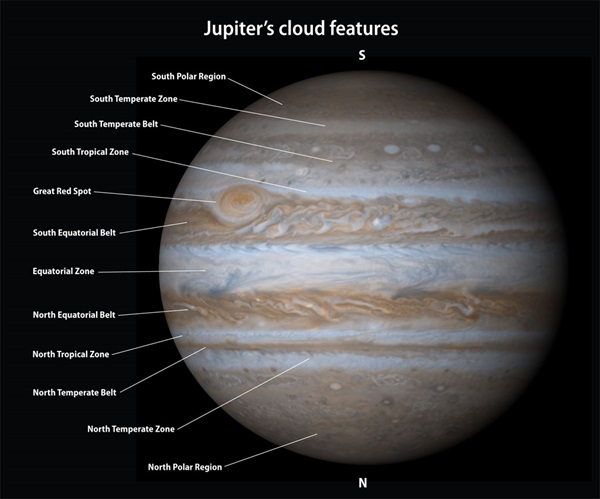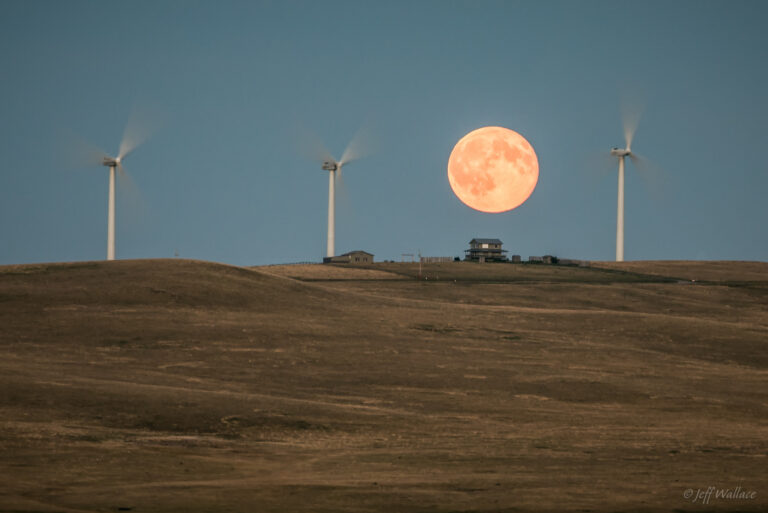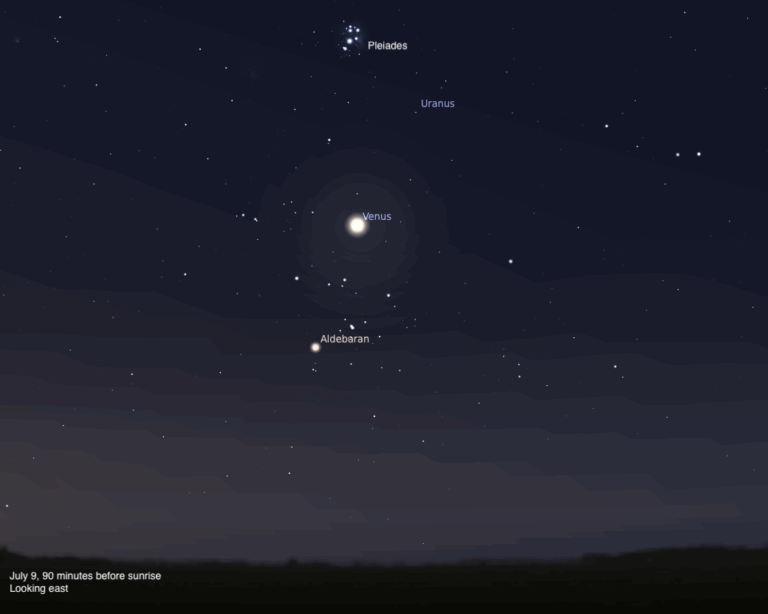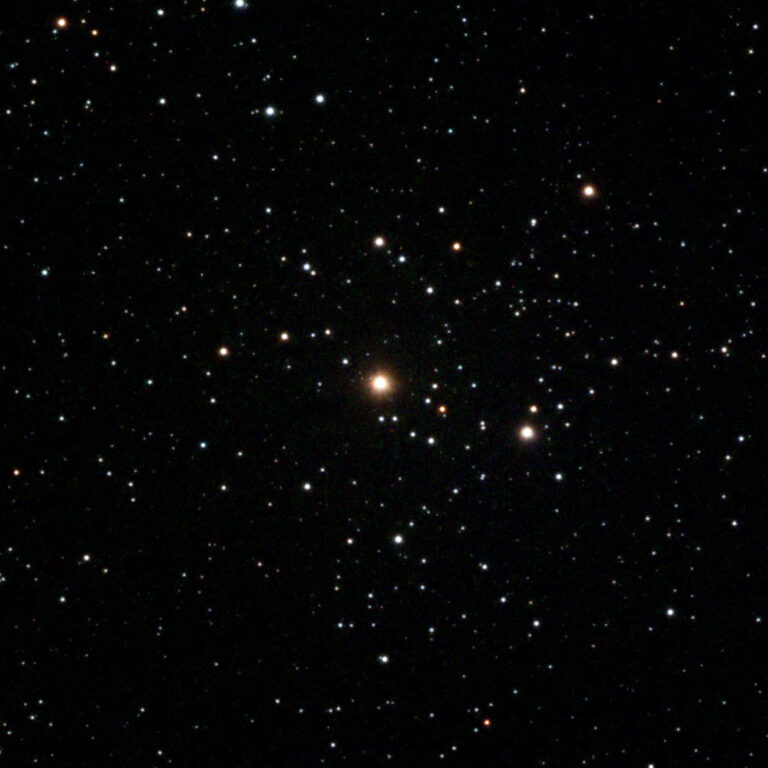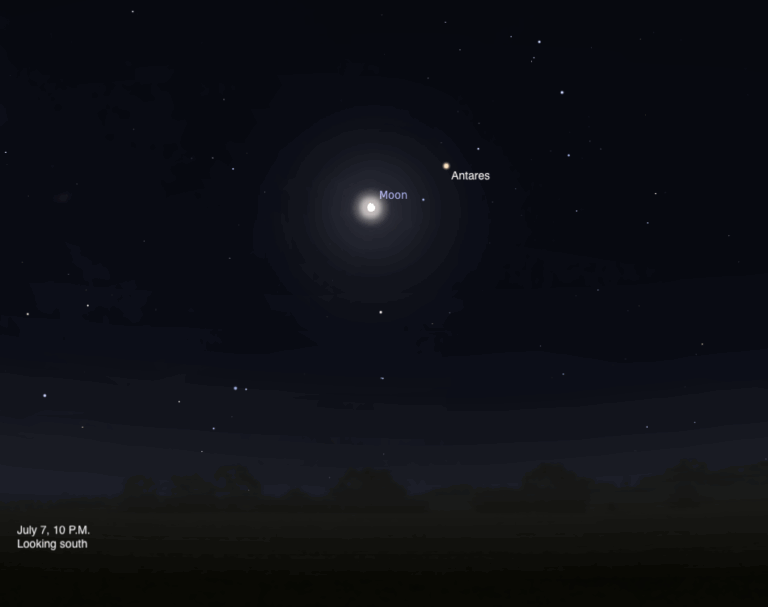Key Takeaways:
• Brilliant Jupiter appears striking in the western sky as darkness falls and remains on display until nearly midnight local daylight time. The giant planet shines at magnitude –1.9 against the backdrop of southern Leo the Lion. Jupiter appears equally dazzling through a telescope, which reveals a wealth of atmospheric features on a disk that spans 34″. Tonight, observers also can see the giant moon Ganymede cross the planet’s northern hemisphere. The transit begin at 10:48 p.m. EDT (best for eastern North America) and lasts for more than three hours (giving western observers good views). There’s a man-made object in the field of view as well, though you can’t glimpse it through any telescope. NASA’s Juno spacecraft entered Jupiter’s mammoth magnetic field on June 25 and is set to enter orbit around the massive world on July 4.
• The Moon reaches perigee, the closest point in its orbit around Earth, at 2:40 a.m. EDT. It then lies 227,411 miles (365,983 kilometers) away from us.
Saturday, July 2
• No holiday better epitomizes summer in the United States than Independence Day. And the season’s namesake asterism — the Summer Triangle — will be on prominent display as fireworks ring out across the land during this holiday weekend. The trio’s brightest member, Vega in the constellation Lyra the Harp, stands nearly overhead shortly after midnight. The asterism’s second-brightest star, Altair in Aquila the Eagle, then lies more than halfway from the southeastern horizon to the zenith. Deneb, the luminary of Cygnus the Swan, marks the Summer Triangle’s third corner. Although it is this asterism’s dimmest star, it’s the brightest point of light in the northeastern sky.
Sunday, July 3
• Although Saturn reached its peak exactly one month ago, it remains a lovely sight. It is on display among the background stars of southern Ophiuchus from nightfall until the start of morning twilight. You can find the planet in the southeast during evening twilight and highest in the south around 11 p.m. local daylight time. Saturn continues to shine brightly, too, at magnitude 0.2. When viewed through a telescope, the planet measures 18″ across while its dramatic ring system spans 41″ and tilts 26° to our line of sight.
Monday, July 4
• If you ever thought the Sun’s distance controlled temperatures here on Earth, today should convince you otherwise. Earth reaches its most distant point from the Sun at noon EDT. At this so-called aphelion, the two lie 94.5 million miles (152.1 million kilometers) apart, some 3.1 million miles (5.0 million km) farther away than they were at perihelion in early January. The Northern Hemisphere’s warm temperatures at this time of year arise because the Sun passes nearly overhead at noon; during winter, the Sun hangs low in the sky.
• New Moon occurs at 7:01 a.m. EDT. At its new phase, the Moon crosses the sky with the Sun and so remains hidden in our star’s glare.
Tuesday, July 5
• Today marks the first full day of autumn in Mars’ northern hemisphere. The Red Planet’s autumnal equinox arrived around noon EDT yesterday, so the Sun is setting over the north pole for the first time in half a martian year (nearly one of Earth’s years). The timing is great for earthbound observers because Mars remains a stunning sight this week. It shines at magnitude –1.3 and dominates the sky toward the south-southwest as darkness falls. When viewed through a telescope, Mars’ orange-red disk spans 16″. The planet’s north polar cap should appear near its minimum extent now that summer is finally over. Look for a patch of white — the permanent cap of water ice — near Mars’ northern limb.
Wednesday, July 6
• Neptune rises shortly before 11:30 p.m. local daylight time this week and climbs some 40° above the southern horizon by the start of morning twilight. The magnitude 7.9 planet lies in Aquarius, some 0.5° southeast of 4th-magnitude Lambda (l) Aquarii. You’ll need binoculars to spy Neptune and a telescope to see its blue-gray disk, which spans 2.3″.
• Mercury passes behind the Sun from Earth’s perspective at 11 p.m. EDT. This means the innermost planet lies on the opposite side of the Sun from Earth and remains hidden in our star’s glare. It will return to view in the evening sky by the end of the month.
Thursday, July 7
• Today marks the peak of Pluto’s 2016 appearance. The distant world reaches opposition, which means it lies opposite the Sun in our sky and remains visible all night. It glows dimly at magnitude 14.1, however, so you’ll need an 8-inch or larger telescope with good optics to spot it visually. Pluto currently lies in northeastern Sagittarius, some 0.3° west-southwest of the 3rd-magnitude star Pi (p) Sagittarii. See “The quest for distant Pluto” in the July Astronomy for complete details on finding this world.
Friday, July 8
• The Moon passes 1° south of Jupiter tomorrow morning, unfortunately after the two objects have dipped below the western horizon. But the view this evening is nearly as nice. The waxing crescent Moon stands 3° to 5° (depending on where in North America you live) to the planet’s lower right. Tomorrow evening, a slightly fatter crescent Moon will appear about twice as far to Jupiter’s upper left.
Saturday, July 9
• The Big Dipper’s familiar shape lies high in the northwest as darkness falls these July evenings. One of the summer sky’s finest binocular double stars marks the bend of the Dipper’s handle. Mizar shines at 2nd magnitude, some six times brighter than its 4th-magnitude companion, Alcor. Even though these two are not physically related, they make a fine sight through binoculars. (People with good eyesight often can split the pair without optical aid.) A small telescope reveals Mizar itself as double — and these components do orbit each other.
Sunday, July 10
• This should be a good night to hunt down asteroid 7 Iris through a small telescope. The 10th-magnitude object lies nearly due south and at its highest position in the sky as darkness falls. Even better, there’s a reasonably bright guide star to point you in the right direction. This evening, look for Iris 0.5° due south of the magnitude 5.0 star Lambda (l) Libr

